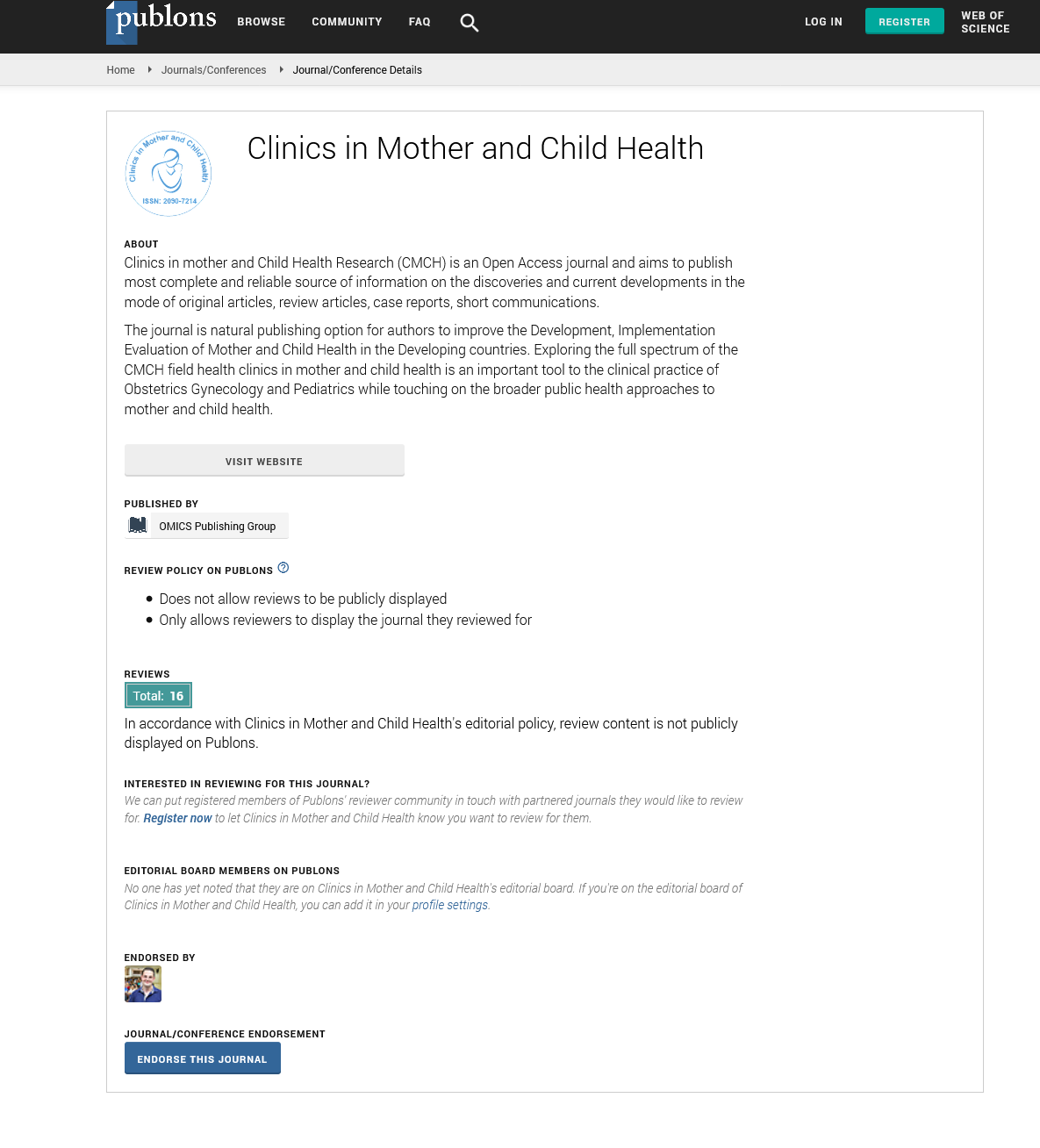Indexed In
- Genamics JournalSeek
- RefSeek
- Hamdard University
- EBSCO A-Z
- Publons
- Geneva Foundation for Medical Education and Research
- Euro Pub
- Google Scholar
Useful Links
Share This Page
Journal Flyer

Open Access Journals
- Agri and Aquaculture
- Biochemistry
- Bioinformatics & Systems Biology
- Business & Management
- Chemistry
- Clinical Sciences
- Engineering
- Food & Nutrition
- General Science
- Genetics & Molecular Biology
- Immunology & Microbiology
- Medical Sciences
- Neuroscience & Psychology
- Nursing & Health Care
- Pharmaceutical Sciences
Opinion Article - (2025) Volume 22, Issue 1
Integrating Telemedicine in Pediatric Healthcare: Enhancing Access and Quality of Care
Pietro Sambati*Received: 03-Jan-2025, Manuscript No. CMCH-25-28563; Editor assigned: 06-Jan-2025, Pre QC No. CMCH-25-28563; Reviewed: 20-Jan-2025, QC No. CMCH-25-28563; Revised: 28-Jan-2025, Manuscript No. CMCH-25-28563; Published: 03-Feb-2025, DOI: 10.35248/2090-7214.25.22.505
Description
Telemedicine has emerged as a transformative solution in pediatric healthcare, improving access, enhancing quality of care and ensuring timely medical interventions. By utilizing digital communication technologies, telemedicine bridges the gap between healthcare providers and patients, especially in underserved and remote areas. Integrating telemedicine into pediatric healthcare has proven to be highly effective in managing acute and chronic conditions, facilitating specialist consultations and ensuring continuity of care. As pediatric healthcare demands unique considerations such as parental involvement, developmental assessments and vaccination schedules, telemedicine offers a versatile platform to address these challenges efficiently.
One of the primary advantages of telemedicine in pediatric healthcare is its ability to improve access to healthcare services. Many families face geographical barriers, particularly in rural or remote regions where pediatric specialists may be limited. Telemedicine platforms enable parents to connect with healthcare providers via video consultations, reducing the need for extensive travel. This accessibility is especially crucial for children with chronic illnesses who require frequent monitoring and follow-up care. Telemedicine also facilitates after-hours consultations, allowing parents to seek medical advice without visiting emergency rooms for non-urgent concerns.
Telemedicine plays a significant role in early diagnosis and intervention, improving outcomes for pediatric patients. Through virtual consultations, healthcare providers can assess symptoms, recommend treatments and advise parents on necessary steps to manage common pediatric conditions such as fever, respiratory infections, rashes and gastrointestinal issues. Moreover, telemedicine allows pediatricians to monitor infants' feeding patterns, sleep routines and developmental milestones remotely, ensuring early identification of potential growth delays or developmental disorders. This proactive approach enables timely intervention, reducing the risk of long-term complications.
In addition to primary care, telemedicine has revolutionized specialist consultations in pediatric healthcare. Access to pediatric neurologists, cardiologists, endocrinologists and mental health professionals often involves lengthy waiting periods and extensive travel. Telemedicine platforms streamline these processes by facilitating virtual specialist appointments, ensuring that children with complex medical needs receive timely care. This model is particularly beneficial for managing conditions such as epilepsy, autism spectrum disorders and congenital heart defects, where continuous monitoring and expert guidance are essential.
Telemedicine also enhances mental and behavioral healthcare for children and adolescents. Pediatric mental health services often face shortages of qualified professionals, leading to delays in diagnosis and treatment. Telemedicine bridges this gap by providing virtual counseling, therapy sessions and behavioral assessments. Children experiencing anxiety, depression, ADHD, or autism spectrum disorders can receive personalized care through secure video platforms, ensuring they have access to consistent mental health support. This approach reduces stigma by offering confidential sessions in a familiar home environment, making children more comfortable discussing their concerns.
Furthermore, telemedicine supports chronic disease management by facilitating continuous monitoring and remote consultations for conditions such as asthma, diabetes and epilepsy. Telemonitoring devices enable healthcare providers to track vital signs, blood glucose levels and medication adherence in real-time, ensuring proactive management of chronic illnesses. Parents can communicate with healthcare professionals regularly, enabling quick adjustments to treatment plans without frequent hospital visits. This model not only improves health outcomes but also reduces the emotional and financial burden on families.
Telemedicine is equally beneficial in improving emergency care for pediatric patients. Virtual triage systems allow parents to consult healthcare providers before visiting emergency departments, helping determine whether immediate care is necessary or if symptoms can be managed at home. This approach minimizes overcrowding in emergency rooms, prioritizes critical cases and ensures efficient allocation of healthcare resources. Telemedicine platforms can also connect emergency care providers with pediatric specialists during critical situations, facilitating real-time guidance for improved decisionmaking in urgent cases.
Parental engagement is a crucial factor in pediatric healthcare and telemedicine offers tools to strengthen communication between parents and healthcare providers. Virtual consultations provide an opportunity for parents to ask questions, clarify treatment instructions and receive educational materials regarding child care, nutrition and preventive health practices. This increased engagement promotes better adherence to treatment plans and empowers parents to make informed healthcare decisions for their children.
Integrating telemedicine in pediatric healthcare also extends to school-based healthcare programs. Schools equipped with telemedicine facilities can provide students with immediate access to healthcare providers for minor illnesses, injury assessments and preventive care. This approach reduces absenteeism, minimizes classroom disruptions and ensures children receive prompt medical attention. School-based telemedicine programs are particularly valuable in underserved regions where healthcare access may be limited.
Despite its numerous benefits, integrating telemedicine into pediatric healthcare requires overcoming certain challenges. Ensuring data security and privacy is essential, especially when handling sensitive pediatric medical records. Healthcare providers must comply with regulations such as HIPAA (Health Insurance Portability and Accountability Act) to maintain confidentiality and ensure secure communication between patients and providers. Additionally, promoting digital literacy among parents and caregivers is crucial to improving their comfort with telemedicine platforms and ensuring effective communication during consultations.
Healthcare institutions must also focus on developing userfriendly telemedicine platforms that cater to pediatric care requirements. Child-friendly interfaces, interactive tools and visual aids can enhance communication with younger patients, ensuring they remain engaged during virtual consultations. Training healthcare providers to effectively assess pediatric conditions via video calls is equally important to ensure accurate diagnoses and treatment planning.
Citation: Sambati P (2025). Integrating Telemedicine in Pediatric Healthcare: Enhancing Access and Quality of Care. Clinics Mother Child Health. 22:505.
Copyright: © 2025 Sambati P. This is an open-access article distributed under the terms of the Creative Commons Attribution License, which permits unrestricted use, distribution and reproduction in any medium, provided the original author and source are credited.

